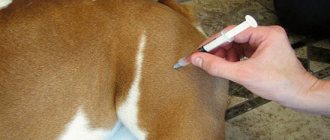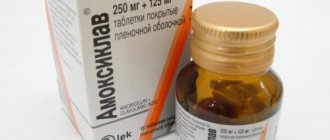Indications for the use of antibiotics
Antibacterial drugs are prescribed by a veterinarian.
The necessary medicine, its dosage and the duration of the course of treatment are determined based on the diagnosis of the sick animal. To do this, a microbiological examination of the dog’s secretions is carried out, a blood test is performed to determine the number of leukocytes, which indicate the presence of infection in the body, and X-rays are taken. In addition, the condition of the animal is important: body temperature, appetite, behavior.
Antibacterial drugs are prescribed by a veterinarian
It should be remembered that antibiotics are not effective against parasitic and viral diseases.
The drugs are indicated in the following situations:
- bacterial eye diseases;
- otitis;
- cystitis;
- mastitis;
- urethritis;
- kidney inflammation;
- staphylococcus;
- open wounds;
- endometritis;
- subcutaneous inflammation;
- pneumonia.
What is ampicillin?
Ampicillin (brand names: Omni-Pen®, Teva-ampicillin®, Polyflex, Aminopenicillin®, Principen®, Princillin®, Totacillin®)
is an antibacterial drug used to treat certain bacterial infections in small and large animals.
Its use in cats, dogs and other small animals to treat certain conditions is “off label” or “off label.” Many drugs are prescribed for off-label uses in veterinary medicine. In these cases, follow your veterinarian's directions and warnings very carefully, as the prescription may differ significantly from what is stated on the medication label.
How to give a dog an antibiotic
Broad-spectrum antibiotics can be given to dogs and other pets only on the recommendation of the treating veterinarian. If the drug is prescribed in tablets, the pill can be crushed into powder, mixed with a small amount of minced meat, porridge, cookies, a piece of raw meat, or canned food.
Important! Not all antibiotics can be given with food, so read the instructions carefully.
Some antibiotics can be dissolved in water and milk. In this case, the medicine is injected into the dog's mouth using a special introducer syringe, which can be purchased at a pet store or veterinary pharmacy, or using a regular disposable syringe without a needle.
You can forcefully give your dog medicine by placing a tablet on the root of the tongue. Secure the pet, open the animal's mouth wide. Wait until the dog swallows the tablet. Reward your pet with his favorite treat.
Diseases requiring antibiotic intervention
The doctor decides what antibiotics to give the dog in a given situation. They will find their use in the following situations:
- For infectious diseases, for example, leptospirosis. There is no alternative treatment; only antibiotics can kill Leptospira bacteria.
- For complications from diseases of various spectrum. In this case, the drugs can be used with other drugs in the fight against the original disease.
- For oncological diseases, since damaged tissue creates favorable conditions for the existence of microbes and bacteria.
- During surgery, injuries and various damage to the skin.
Classification of antibacterial agents
When choosing an antibacterial medication, it is important to determine its active ingredient, which is active against a specific type of bacteria. In addition, you need to know the classification of drugs.
By type of action
Antibacterial medications, depending on the principle of action on microorganisms, are divided into 2 types:
- Bacteriostatic. They have a suppressive effect on the vital activity and reproduction of pathogenic bacteria, but do not destroy them.
- Bactericidal. Substances that completely kill viruses. Subsequently, they are eliminated from the body naturally.
Classification according to the nature of the effect on the bacterial cell
By release form
Depending on which organ is subject to therapeutic therapy, the veterinarian determines the appropriate form of release of the antibacterial drug. According to this criterion, medications are classified as follows:
- Contact drugs. These include ointments, creams, various powders, drops. The active substances of the medicine act locally, exclusively on the treated area.
- Injections. The medication, administered intravenously or intramuscularly, has a systemic effect on the body of a sick pet.
- Tablets, suspensions, powders. They are also characterized by systemic effects, as they have a more pronounced effect.
Related article: How to choose the best anthelmintic for dogs
Antibacterial drugs are also divided into pharmacological groups:
- Penicillins (“Ampicillin”, “Amoxiclav”). Medicines are effective for dermatological lesions of an infectious nature.
- Cephalosporins (“Cephalexin”, “Cefazolin”). Prescribed for inflammatory processes of the urinary tract and gastrointestinal tract.
- Tetracyclines (“Doxycycline”, “Tetracycline”). Used in cases of infectious ophthalmological diseases, infections of the genitourinary system.
- Macrolides (“Erythromycin”, “Azithromycin”). The safest category of antibiotics. Used in the prevention of diseases of the respiratory system and gastrointestinal tract.
Classification of antibacterial agents by chemical structure
Dosage and rules of drug administration
The duration of treatment is prescribed depending on the type of disease. Therapy can last from two days to several months.
Only a veterinarian can prescribe the correct dosage and duration of treatment.
For example, cystitis requires long-term therapy. A urine test is performed every two weeks to understand how the treatment is progressing. It is important to have regular urine tests. Since outwardly the dog may already be healthy, however, tests can show the further course of the disease. If the animal owner stops taking antibiotics based only on external signs, the disease may return in an aggravated form.
Rules for administering antibiotics:
- first you need to determine whether the animal has an infection;
- after this, the causative agent of the infection is determined and an antibiotic is selected that is effective specifically against this microorganism;
- the selection of antibiotics takes into account its concentration in the infectious focus;
- when choosing a medication, it is important to take into account additional factors that directly affect the effectiveness of therapy (for example, the presence of pus or necrotic tissue);
- a flexible regime for the use of antibacterial agents is selected;
- Antibiotics are usually used for a long period to completely get rid of the disease and prevent relapses.
As for the methods of administering the medicine, there are some nuances. Thus, the concentration of the active substance in tablets should be twice as high as in the solution for injection. It is also important to consider that some medications cannot be given at the same time as food, since in this case they are not absorbed into the gastrointestinal tract or are destroyed by enzymes.
Injections with antibiotics are prescribed in the following cases:
- pets are in serious condition;
- animals are vomiting and have no appetite;
- if the required drug is not available in tablet form.
In other cases, the method of administration is chosen that is more convenient for the owner. Suspensions are more often prescribed to puppies - they are easier to administer, have a pleasant taste and are easier to dose.
In order to give your dog antibiotic tablets, you need to do the following:
- open the animal's mouth;
- put the tablet in the middle of the tongue (if you put the medicine on the edge of the tongue, the animal will quickly push it back);
- Close your pet's mouth and hold him with your hands until he swallows it.
What antibiotics should dogs be treated with?
Groups of antibacterial agents are the same in structure and purpose in both human and veterinary medicine. The differences are only in dosages and production method.
The following groups of antibiotics are used to treat dogs:
- penicillins, including semi-synthetic ones (Ampicillin, Amoxicillin, Amoxiclav, etc.);
- cephalosporins, which are divided into four generations and are effective against gram-negative bacteria;
- macrolides, they are usually used for diseases of the respiratory system (Erythromycin, Azithromycin, Macropen, etc.);
- carbapenems - most often used against staphylococci (Meropenem, Meronem, Imipinem, etc.);
- tetracyclines - indicated for cystitis and borreliosis in dogs (Tetracycline, Terramycin, Biomycin, Doxycycline, etc.);
- aminoglycosides - effective against gram-negative flora, but have high toxicity, therefore they are used strictly according to indications (Gentamicin, Kanamycin, etc.);
- chloramphenicol – prescribed for diseases of the gastrointestinal tract;
- fluoroquinolones - used in the treatment of cystitis, gastrointestinal infections, severe pneumonia (Ofloxacin, Ciprofloxacin, etc.);
- fungicides - needed to combat pathogenic fungi (Nystatin, Levorin, etc.).
There is also a group of anti-tuberculosis drugs that are great for people, but can be fatal for dogs.
Antibiotics for pets, as for people, can have a bacteriostatic or bactericidal effect. Bacteriostatic drugs stop the proliferation of bacteria, and bactericidal drugs kill pathogens.
If for some reason it is not possible to immediately identify the cause of the infection, the dog is prescribed broad-spectrum antibiotics. Such drugs fight against several pathogens at once.
Mechanism of action of antibiotics
Antibiotics are often used because of their broad spectrum of action. They can cope with almost all pathogenic microorganisms. But they do it in different ways. Thus, an injection of an antibiotic into a dog leads to the fact that the components of the drug disrupt the metabolism of pathogenic cells, thereby preventing them from living normally. Other medications block the proliferation of pathogens, causing them to become fewer and fewer.
Antimicrobial drugs for dogs are divided into bactericidal and bacteriostatic. Both groups of drugs are aimed at destroying harmful microbes in the body, but they act differently:
- Bactericidal antibiotics destroy bacteria present in the pet’s body;
- Bacteriostatic prevents the growth and reproduction of malignant bacteria.
Both groups of antibiotics can be used separately or together. Modern veterinary pharmacology offers a range of antimicrobial drugs in the form of injection ampoules, tablets, ointments and sprays. The choice of release form depends on the needs of the patient.
Pros and cons of antibiotic therapy
Pros:
- Quick effect even in case of serious complications of the disease.
- Medicines have a wide spectrum of action.
- Relatively short courses of therapeutic therapy.
- Eliminating the risk of secondary infection. This significantly reduces the risk of complications.
Minuses:
- If the dosage or duration of treatment is incorrectly set, the risk of side effects increases. In addition, there is a significant weakening of the animal’s body.
- Many drugs can cause the so-called addiction of viruses to the active substances of the drug. As a result of long-term treatment, the effectiveness of drugs is significantly reduced.
- Disorder of the microflora of the gastrointestinal tract.
How to give an antibiotic to a dog?
It is not recommended to select the drug on your own. In addition to the fact that the medication may not help in treating the disease, its use is fraught with complications.
Antibacterial drugs can only be used as prescribed by a veterinarian
- Before choosing a product, it is necessary to give the dog a sensitivity test and conduct a laboratory test to determine its susceptibility to the active substances.
- If your pet has a viral disease, antibiotics are used only in case of complications.
- It is prohibited to deviate from the dosage specified in the instructions. This is fraught with intoxication of the body.
- The antibiotic must be administered at the same time every day. This is due to the fact that the level of medication in the blood must be constantly maintained.
- If signs of improvement appear, you should not stop the course of treatment. It is necessary to strictly adhere to the terms of therapy specified by the doctor.
- If an antibiotic is prescribed in the form of tablets, it is forbidden to forcibly squeeze the pet’s jaw. This may cause injury.
- If you have difficulty taking the tablets, the drug should be crushed and mixed with minced meat, canned food or porridge. You must first read the instructions, since not all products can be combined with food.
The tablet should be placed on the root of the tongue and the dog should be allowed to swallow it.
An overdose of the drug is accompanied by diarrhea and vomiting. Sometimes deafness is possible.
Injections cannot be given intravenously: only subcutaneously or intramuscularly
Rules for choosing a syringe
To reduce pain when injecting medication, you need to choose the needle size wisely.
Table 3. Rules for selecting a syringe
| Dimensions of the dog | Syringe characteristics |
| Small | Insulin:
|
Not suitable for administering large doses of medication. If your pet's skin is thick, the sharp end of the needle becomes bent. As a result, you have to put in extra effort during the injection.
An alternative is a tuberculin syringe:
- needle length - from 13 to 25 mm;
- diameter - from 0.3 to 0.5 mm;
- capacity - 0.1 ml.
Allows painless injection into the subcutaneous layer
Medium or large Since the dosage is calculated based on the weight of the animal, a 2 or 5 ml syringe should be used. In order not to unnecessarily injure the skin tissue, you should attach a needle of small diameterHow to treat a dog's wound yourself
If an injury is detected in a furry pet, the owner must provide emergency assistance. Veterinary experts recommend performing the following independent manipulations:
It is not recommended to use alcohol solutions of iodine or brilliant green to treat wounds. These drugs can cause dryness and even skin. For the same reason, alcohol, vodka and other alcohol-containing liquids should not be used to treat damage.
- To disinfect the wound canal with antiseptic solutions, it is convenient to use gauze wipes and a rolled bandage. In the field, you can use a clean scarf or piece of cotton fabric.
- A small amount of anti-inflammatory ointment must be injected into the wound using a syringe without a needle. For this purpose, chloramphenicol or streptomycin ointment, Levomekol, is suitable.
- The wound can be sprinkled with streptocide powder.
- After treatment, the wound surface must be covered with gauze. This will help reduce the risk of infection and promote longer retention of drugs in the pathological focus.
- The dog should not be allowed to lick or injure the wound with its limbs. For this purpose, a bandage is applied or a special one is put on the animal’s neck to prevent the pet from harming itself.
Self-treatment of a wound does not in any way exclude a visit to a specialized institution with your furry pet.
Popular drugs
The pharmaceutical veterinary market is rich in antibacterial drugs, which differ in their principle of action, composition, and release form. It is important for the dog owner to understand that self-prescribing this or that medication is fraught with serious complications. However, it is still worth familiarizing yourself with the list of popular medications.
"Tsiprovet"
This is a relatively safe systemic agent. Available in the form of tablets and drops. Drops are widely used for ophthalmological diseases characterized by infectious origin: blepharitis, conjunctivitis, uveitis, corneal ulcer. "Tsiprovet" is also indicated in the case of purulent processes in the eyes.
The tablets are effective for bronchitis, pneumonia and other viral diseases. In addition, the medication is active in cases of inflammation of the genitourinary system and infectious diseases of the gastrointestinal tract. The drug is also prescribed for lesions of soft tissues, bones, and joints.
"Tsiprovet" is contraindicated for pregnant and lactating bitches, puppies, and animals with disorders of the central nervous system.
"Amoxicillin"
A complex action drug that effectively destroys pathogenic bacteria and viruses. The product is produced in the format of injections, suspensions and tablets. The components of the medication are active in the case of diseases of the genitourinary system and gastrointestinal tract.
Similar article: Instructions and tips for using Cantaren for dogs
Injection dose: 1 ml per 10 kg of animal weight. The dose of tablets is calculated similarly. Amoxicillin is contraindicated in dogs that are intolerant to certain components of the drug.
"Amoxicillin" is a complex action drug
"Marfloxin"
The medication is available in the form of injections and tablets. The drug is prescribed for respiratory diseases, inflammation of the genitourinary system, and soft tissue lesions. Marfloxin is not prescribed to puppies under 1.5 years of age or to animals with congenital or acquired diseases of the central nervous system.
"Ceftriaxone"
This is a systemic antibiotic that has a prolonged bactericidal effect. Prescribed in case of otitis media, sepsis, inflammation of the brain, respiratory diseases, inflammation of the urinary tract. The drug is widely used in postoperative rehabilitation therapy to eliminate the risk of complications.
"Ceftriaxone" is strictly contraindicated in pregnant and lactating dogs, puppies, as well as animals suffering from renal failure.
"Amoxiclav" tablets
The product has a pronounced bactericidal effect, which consists in inhibiting protein synthesis in viral cells. The medicine is prescribed for infectious dermatological lesions, diseases of the genitourinary system, and respiratory diseases.
The drug is contraindicated in dogs sensitive to penicillin.
"Amoxiclav" has a pronounced bactericidal effect
"Betamox"
"Betamox" has a systemic prolonged effect. Effective in cases of diseases of the genitourinary system, gastrointestinal tract, infectious lesions of the respiratory system. "Betamox" injections are actively used in veterinary medicine for dermatological lesions of a bacterial nature.
"Gentamicin 8%"
The medicine is characterized by a pronounced antimicrobial effect. It is produced in the form of a solution for injection in a volume of 100 ml. The product is used to treat staphylococcal infections, diseases of the joints and bones, and inflammation of the genitourinary system.
"Gentamicin 8%" is not prescribed to dogs suffering from renal or liver failure.
"Engemicin"
The antibacterial medication is available in the form of an injection solution with a yellowish tint. The medicine has an antimicrobial effect. Prescribed for animals suffering from colds, infectious bronchitis, cystitis, pleurisy and their complications. It is used to prevent diseases caused by gram-positive and gram-negative pathogenic bacteria.
Similar article: Homeopathic remedy "Chondartron" for dogs: benefits and possible contraindications
"Ceftriaxone"
An antibiotic with a medium toxicity class. Characterized by a prolonged antimicrobial effect. The drug is prescribed for otitis media, inflammation of the brain, sepsis, and bone tissue lesions.
"Ceftriaxone" is characterized by a prolonged antimicrobial effect
Amoxicillin
The drug against infections is aimed at combating various microorganisms. Excellently absorbed and sensitive to stomach acids. Available in the form of tablets (250 and 500 ml) and injection suspensions (15% and 20%).
Purpose
In veterinary practice, the drug Amoxicillin is used for infections that were caused by microorganisms sensitive to this substance in the gastrointestinal tract, genitourinary system, as well as for respiratory diseases and in surgery.
This drug is effective for the following common diseases:
- leptospirosis;
- bronchitis, rhinitis;
- cystitis, endometritis, pyelonephritis;
- gastroenteritis.
Dosage and contraindications
When using an injection solution (intramuscular), the calculation is based on the principle of 1 ml per 10 kg of weight (15 mg of the main active ingredient amoxicillin per kilogram of weight). Tablets are calculated in the same way.
The drug is not intended for intravenous administration, is not combined with bacteriostatic and chemotherapeutic substances, and is not mixed with other prescribed drugs in the same syringe. Amoxicillin is not prescribed to animals with a sensitive reaction to the active ingredient, as well as to other substances of the penicillin group. Remember that trembling when administering the drug is a sign of fear in your pet!
Types of antibiotics for dogs
There are no special antibacterial agents developed exclusively for animals. The range of veterinary pharmacies is represented by drugs similar to humans, but in a lower dose. As a rule, doctors use medications with complex effects.
Multifunctional antibiotics successfully fight many types of gram-positive and gram-negative bacteria. Their use is especially justified when the disease cannot be diagnosed or there is a need to stop dangerous symptoms as soon as possible.
The success of therapy depends on the sensitivity of bacteria to the drug
Learn about essential antimicrobials in animals
- Trichopolum instructions for veterinary medicine
- Instructions for the use of the antibiotic Baytril in animals
- Instructions for using metronide
- Use of ceftriaxone for animals
- Use of Metrogyl in animals
- Instructions for doxycycline in animals
- Metronidazole (Metronidazole) for animals (instructions for use in veterinary medicine, doses, indications and contraindications)
- Atovaquone (ATOVAQUONE)
- Azithromycin for veterinary use
Basic rules of antibiotic therapy
In order for the course of therapeutic therapy to go smoothly, you must follow the basic rules:
- Contact your veterinarian. He will tell you what medications can be given in a particular case, determine the dosage for a particular pet, and establish a course of treatment.
- Follow the dosage. Even if the dog is on the mend, you cannot stop taking the prescribed medications.
- Follow the intake schedule. This will ensure that the components operate as efficiently as possible.
- Observe the condition of the animal. Note any changes in his behavior. If it worsens, you should immediately consult a doctor.
Possible consequences
If you correctly calculate the dosage and course of treatment of antibiotics, there will be no negative consequences for the life and health of dogs. However, this is only possible if the medications are prescribed to professionals after a thorough examination of the animal. Therefore, do not self-medicate under any circumstances, but immediately go to a veterinary clinic for qualified consultation, diagnosis and proper treatment.
However, it is best to try to treat your dog without using antibiotics. These medications are used in extreme cases. IMPORTANT! Collies, Australian Shepherds and Bobtails are prohibited from consuming Erythromycin, Grepafloxacin and Sparfloxacin. "Doscorubicin" and "Actinomycin" should be given carefully, constantly monitoring the pet.
Many four-legged owners abuse antibiotics, buying drugs at the slightest sign of illness. Such an approach is fraught with the emergence of resistance of pathogens to antibacterial agents. Therefore, before purchasing antibiotics, you should strictly follow the veterinarian’s recommendations. Do not forget that these drugs are not recommended for use in the treatment of viral diseases. To avoid the use of drugs with such a spectrum of action, it is necessary to regularly check the health of your pet with a veterinarian and monitor the quality of food.
Consequences of improper prescription and administration of medications
Antibiotics for dogs, taken without a clear reason, can lead to the development of bacterial stability, in fact, to the absence of a therapeutic response, destruction of the intestinal microflora, and the appearance of toxins in vital organs: liver, kidneys and others.
To avoid difficulties with the intestinal microflora, it is imperative to undergo a course of treatment with probiotics. They contain beneficial bacteria that can restore the balance of intestinal flora.
The pharmaceutical market can offer various forms of drugs for animals.
It is not always that a dog can immediately return to its usual form after antibiotics, so if there is a chance not to resort to using them, it is worth taking advantage of it. It is recommended to visit a veterinarian and get advice on the use of natural medicines that can strengthen the immune system and actively combat the growing infection.
Side effects and contraindications
In case of non-compliance with the prescribed dosage or intolerance to the components of the drug, the following side effects may occur:
- nausea and vomiting;
- loss of appetite;
- apathy;
- diarrhea;
- allergy.
The main contraindications to the use of most antibacterial agents are pregnancy, lactation, young age (up to one and a half years), and individual intolerance.
The use of antibiotics significantly alleviates the course of the disease and leads to a speedy recovery of the pet. But it is strictly not recommended for a dog owner to prescribe the medicine on his own. The incompetence of the owner can cost the health or even the life of the animal.
Recommended Posts
Standard height and weight of the Cane Corso breed by month
Weight of a puppy and an adult Labrador by month
Weight and height of a German Shepherd puppy by month
Description and content of the hunting border terrier
Description and care of the highly intelligent Border Collie breed
Description of forms and features of treatment of enteritis in cats
Marfloxin
A broad-spectrum antibiotic used to combat microorganisms that cause infections and inflammation of various organs and systems in dogs. The active ingredient is marbofloxacin, the release form is tablets or solution for injection.
Dosage and contraindications
Marfloxin is not prescribed to animals with individual sensitivity to the components of the drug, as well as to animals with damage to the nervous system (shivering), as well as when the microorganism is resistant to other representatives of the fluoroquinolone group. Marfloxin should also not be given to puppies under the age of one year in medium and small breeds, and up to 18 months in large dogs.
The drug is given to the pet once a day (orally or intramuscularly) at a rate of 2 mg of active substance per kilogram of body weight. The duration of treatment depends on the type of lesion and can range from five to forty days. Marfloxin does not combine with calcium, macrolides, iron, tetracyclines and chloramphenicol. If the technique causes trembling in the dog, then it is first necessary to calm the pet.
It is strictly forbidden to combine
Not all antibiotics can be mixed with each other. In addition to neutralizing each other’s effects, there is also complete incompatibility, which threatens with serious consequences for the body!
Do not mix or administer at the same time:
- Cephalosporins with penicillins and polymyxin (pharmacological incompatibility).
- Carbapenem with beta-lactams (full antagonists).
- Fluoroquinolones and nitrofurans completely neutralize each other's effects.
- Penicillin antibiotics cannot be mixed with aminoglycosides (in particular with gentamicin) in the same syringe - the ototoxic effect of the latter is enhanced, leading to hearing loss
How should I store ampicillin?
Ampicillin trihydrate powder should be stored below 25°C and the reconstituted suspension should be stored for up to 3 months in the refrigerator at 2° to 8°C. Oral tablets, capsules and powder should be stored at room temperature between 15° and 30°C. °C. Once reconstituted, the oral suspension should be refrigerated and discarded after 14 days. It can be stored at room temperature, but in these cases it should be thrown away after 7 days.











